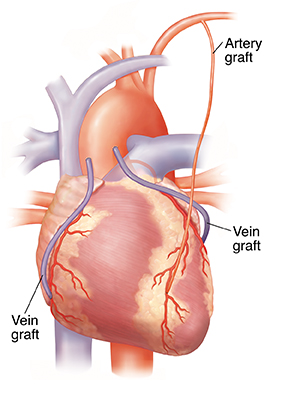Understanding Off-Pump Coronary Artery Bypass (CABG) Surgery
Understanding Off-Pump Coronary Artery Bypass (CABG) Surgery

What is off-pump CABG?
Off-pump heart surgery is done without the use of a heart-lung machine. The machine is called a cardiopulmonary bypass. Instead, the heart pumps blood on its own to the rest of your body during the surgery. This is also known as “beating heart surgery.”
During CABG, a surgeon takes an artery or a vein from another place in your body. It’s most often taken from the chest wall or a leg. This blood vessel is known as the graft. This is the “G” in CABG. That artery or vein is then attached above and below the blocked area of the coronary artery. This lets blood bypass the blocked area, and restores normal blood flow to the heart. Your health care provider may plan the surgery in advance, or you might need it in an emergency if a vessel suddenly becomes blocked.
Why off-pump CABG is done
The surgery can help reduce chest pain and the risk for a heart attack.
How off-pump CABG is done
Your procedure will be done by a cardiac surgeon. This is a doctor who treats diseases of the heart. The surgery can be done in more than one way.
You’ll be given medicine to prevent pain and put you to sleep during the surgery (general anesthesia). The anesthesiologist will watch your breathing and vital signs during the surgery. He or she will also give you blood thinning medicine.
Your surgeon will make a cut (incision) to remove a blood vessel from another part of your body. This is the graft. The graft vessel is most often taken from your chest wall or your leg.
Your doctor will make an incision down the middle of your chest. He or she will then separate your breastbone to reach your heart.
A device is placed on the heart to help stabilize the area being grafted. Your surgeon will attach one end of the graft to the diseased coronary artery beyond the blockage. The other end of the graft will be attached to the aorta. The aorta is the main blood vessel leading from the heart out to the body. The attachment is usually done with sutures.
Risks of off-pump CABG
All surgery has some risks. The risks of off-pump CABG include:
Infection
Bleeding
Irregular heart rhythms
Blood clots that can lead to stroke or heart attack
Complications from anesthesia
Kidney failure
Need for a future procedure to improve the heart’s blood supply
Heart attack
Grafts that don’t work properly
Death
Your own risks may vary according to your age, your general health, and other factors. Talk with your healthcare provider about which risks apply most to you.
Updated:
March 21, 2017
Sources:
Aldea GS. Minimally invasive coronary artery bypass graft surgery: definitions and technical issues. UpToDate., Polomsky M, Puskas JD. Off-pump coronary artery bypass grafting: the current state. Circulation Journal. 2012;76:784-90., Stulak, JM. Off-pump and minimally invasive direct coronary artery bypass graft surgery: Outcomes. UptoDate.
Reviewed By:
Fetterman, Anne, RN, BSN,Image reviewed by StayWell medical illustration team.,Mancini, Mary, MD